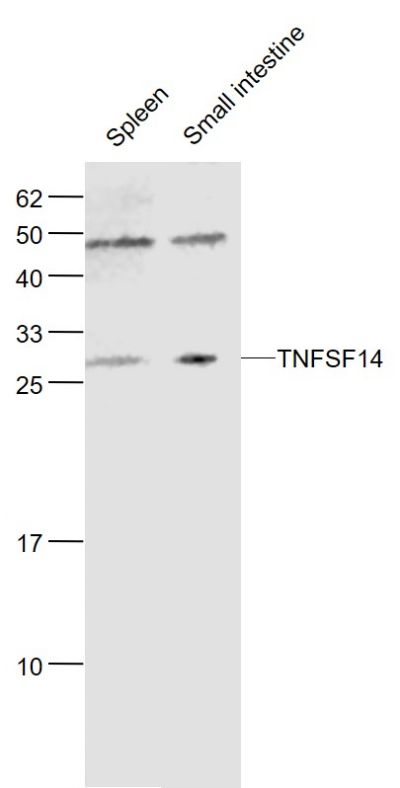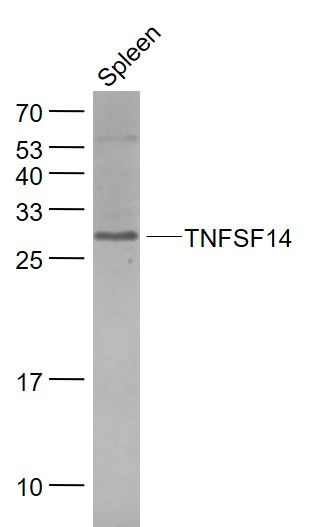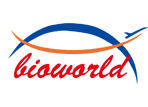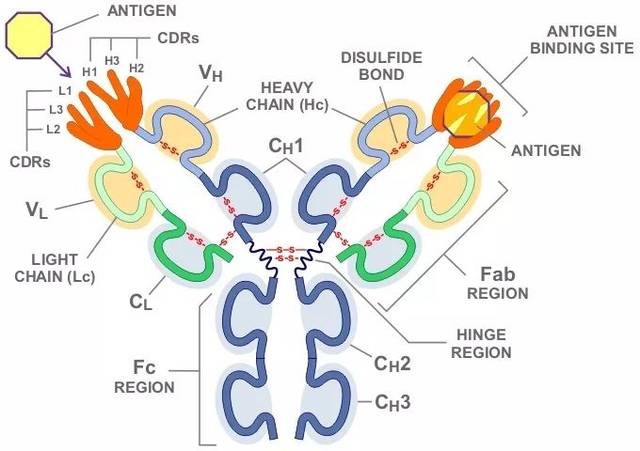Product Name :
TNFSF14 polyclonal antibody Background :
LIGHT protein is a type II transmembrane protein and a tumor necrosis factor (TNF) ligand superfamily member (TNFSF14). LIGHT is expressed on activated T cells and immature dendritic cells and its receptors have been identified as lymphotoxin-Beta receptor (LTBetaR) and the herpesvirus entry mediator (HVEM), both of which lack the cytoplasmic sequence termed as "death domain." LIGHT is first identified as HVEM ligand (HVEM-L) and a deterrent to herpesvirus infection according to its ability to compete with HSV glycoprotein D for HVEM binding. As a T cell-derived costimulatory ligand, TNFSF14 plays a crucial role in T cell activation and proliferation by LIGHT-LTBetaR interaction, and it is necessary and sufficient for LIGHT-mediated apoptosis of tumor cells. Additionally, recent studies also establish a direct role for LIGHT in NK activation/expansion via LIGHT-HVEM interaction, and thus breaking T-cell tolerance at the tumor site. Accordingly, LIGHT is suggested to be involved in CTL-mediated tumor rejection, allograft rejection and graft versus host disease. Although known as lymphotoxin-Gamma, LIGHT plays a minimal role in lymphoid tissue development in contrast with LT-Alpha and Beta. This protein was also demonstrated to inhibit TNF-Alpha-mediated but not Fas- or TRAIL-mediated apoptosis of human primary hepatocytes. Product :
0.01M TBS(pH7.4) with 1% BSA, 0.03% Proclin300 and 50% Glycerol. Storage&Stability :
Store at 4°C short term. Aliquot and store at -20°C long term. Avoid freeze-thaw cycles. Specificity :
TNFSF14 polyclonal Antibody detects endogenous levels of TNFSF14 protein. Immunogen :
KLH conjugated synthetic peptide derived from mouse TNFSF14:59-130/239
Conjugate :
Unconjugated Modification :
Unmodification
TNFSF14 polyclonal antibody Background :
LIGHT protein is a type II transmembrane protein and a tumor necrosis factor (TNF) ligand superfamily member (TNFSF14). LIGHT is expressed on activated T cells and immature dendritic cells and its receptors have been identified as lymphotoxin-Beta receptor (LTBetaR) and the herpesvirus entry mediator (HVEM), both of which lack the cytoplasmic sequence termed as "death domain." LIGHT is first identified as HVEM ligand (HVEM-L) and a deterrent to herpesvirus infection according to its ability to compete with HSV glycoprotein D for HVEM binding. As a T cell-derived costimulatory ligand, TNFSF14 plays a crucial role in T cell activation and proliferation by LIGHT-LTBetaR interaction, and it is necessary and sufficient for LIGHT-mediated apoptosis of tumor cells. Additionally, recent studies also establish a direct role for LIGHT in NK activation/expansion via LIGHT-HVEM interaction, and thus breaking T-cell tolerance at the tumor site. Accordingly, LIGHT is suggested to be involved in CTL-mediated tumor rejection, allograft rejection and graft versus host disease. Although known as lymphotoxin-Gamma, LIGHT plays a minimal role in lymphoid tissue development in contrast with LT-Alpha and Beta. This protein was also demonstrated to inhibit TNF-Alpha-mediated but not Fas- or TRAIL-mediated apoptosis of human primary hepatocytes. Product :
0.01M TBS(pH7.4) with 1% BSA, 0.03% Proclin300 and 50% Glycerol. Storage&Stability :
Store at 4°C short term. Aliquot and store at -20°C long term. Avoid freeze-thaw cycles. Specificity :
TNFSF14 polyclonal Antibody detects endogenous levels of TNFSF14 protein. Immunogen :
KLH conjugated synthetic peptide derived from mouse TNFSF14:59-130/239
Unconjugated Modification :
Unmodification
-
 Anti-TNFSF14 at 1/1000 dilution
Anti-TNFSF14 at 1/1000 dilution -
 Anti- TNFSF14 at 1/1000 dilution
Anti- TNFSF14 at 1/1000 dilution
Bioworld Biotech only provide peptides for our antibodies and do not provide additional peptide customization services.
Price/Size :
USD 368/1mg/vial
Tips:
For phospho antibody, we provide phospho peptide(0.5mg) and non-phospho peptide(0.5mg).Describe :
Blocking peptides are peptides that bind specifically to the target antibody and block antibody binding. These peptide usually contains the epitope recognized by the antibody. Antibodies bound to the blocking peptide no longer bind to the epitope on the target protein. This mechanism is useful when non-specific binding is an issue, for example, in Western blotting (WB) and Immunohistochemistry (IHC). By comparing the staining from the blocked antibody versus the antibody alone, one can see which staining is specific; Specific binding will be absent from the western blot or IHC performed with the neutralized antibody.Formula:
Synthetic peptide was lyophilized with 100% acetonitrile and is supplied as a powder. Reconstitute with 0.1 ml DI water for a final concentration of 10 mg/ml.The purity is >90%,tested by HPLC and MS.
Storage:
The freeze-dried powder is more stable. For short time at 2-8°C. For long term storage store at -20°C.
Note :
This product is for research use only (RUO only). Not for use in diagnostic or therapeutic procedures.
 TNFSF14 polyclonal antibody
TNFSF14 polyclonal antibody  Datasheet
Datasheet COA
COA MSDS
MSDS SHIP
SHIP